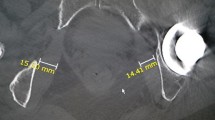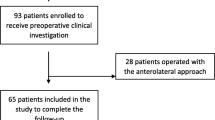Abstract
We modified the posterior approach by preserving the external rotator muscles to enhance joint stability after primary THA. We asked whether this modified posterior approach would have a lower dislocation rate than the conventional posterior approach, with and without a repair of external rotator muscles. We retrospectively divided 557 patients (670 hips) who had undergone primary THA into three groups based on how the external rotator muscles had been treated during surgery: (1) not repaired after sectioning, (2) repaired after sectioning, or (3) not sectioned and preserved. The minimum followup was 1 year. In the group with preserved external rotator muscles, we observed no dislocations; in comparison, the dislocation rates for the repaired rotator group and the no-repair group were 3.9% and 5.3%, respectively. This modified posterior approach, which preserves the short external rotator muscles, seemed effective in preventing early dislocation after primary THA.
Level of Evidence: Level III, therapeutic study. See the Guidelines for Authors for a complete description of levels of evidence.



Similar content being viewed by others
References
Biedermann R, Tonin A, Krismer M, Rachbauer F, Eibl G, Stöckl B. Reducing the risk of dislocation after THA: the effect of orientation of the acetabular component. J Bone Joint Surg Br. 2005;87:762–769.
Bischoff R, Dunlap J, Carpenter L, DeMouy E, Barrack R. Heterotopic ossification following uncemented THA: effect of the operative approach. J Arthroplasty. 1994;9:641–644.
Harris WH. Traumatic arthritis of the hip after dislocation and acetabular fractures: treatment by mold arthroplasty: an end-result study using a new method of result evaluation. J Bone Joint Surg Am. 1969;51:737–755.
Hedley AK, Hendren DH, Mead LP. A posterior approach to the hip joint with complete posterior capsular and muscular repair. J Arthroplasty. 1990;5(Suppl):S57–S66.
Hovelius L, Hussenius A, Thorling J. Posterior versus lateral approach for hip arthroplasty. Acta Orthop Scand. 1977;48:47–51.
Komeno M, Hasegawa M, Sudo A, Uchida A. Computed tomographic evaluation of component position on dislocation after THA. Orthopedics. 2006;29:1104–1108.
Kwon MS, Kuskowski M, Mulhall KJ, Macaulay W, Brown TE, Saleh KJ. Does surgical approach affect THA dislocation rates?. Clin Orthop Relat Res. 2006;447:34–38.
Masaoka T, Yamamoto K, Shishido T, Katori Y, Mizoue T, Shirasu H, Nunoda D. Study of hip joint dislocation after THA. Int Orthop. 2006;30:26–30.
Masonis JL, Bourne RB. Surgical approach, abductor function, and THA dislocation. Clin Orthop Relat Res. 2002;405:46–53.
Mihalko WM, Whiteside LA. Hip mechanics after posterior structure repair in THA. Clin Orthop Relat Res. 2004;420:194–198.
Morrey BF, Adams RA, Cabanela ME. Comparison of heterotopic bone after anterolateral, transtrochanteric, and posterior approaches for THA. Clin Orthop Relat Res. 1984;188:160–167.
Nishii T, Sugano N, Miki H, Koyama T, Takao M, Yoshikawa H. Influence of component positions on dislocation: computed tomographic evaluations in a consecutive series of THA. J Arthroplasty. 2004;19:162–166.
Pätiälä H, Lehto K, Rokkanen P, Paavolainen P. Posterior versus lateral approach for hip arthroplasty. Acta Orthop Scand. 1977;48:47–51.
Pellicci PM, Bostrom M, Poss R. Posterior approach to total hip replacement using enhanced posterior soft tissue repair. Clin Orthop Relat Res. 1998;355:224–228.
Roberts JM, Fu FH, McClain EJ, Ferguson AB. A comparison of the posterolateral and anterolateral approaches to THA. Clin Orthop Relat Res. 1984;187:205–210.
Sierra RJ, Raposo JM, Trousdale RT, Cabanela ME. Dislocation of primary THA done through a posterolateral approach in the elderly. Clin Orthop Relat Res. 2005;441:262–267.
Stähelin T, Drittenbass L, Hersche O, Miehlke W, Munzinger U. Failure of capsular enhanced short external rotator repair after total hip replacement. Clin Orthop Relat Res. 2004;420:199–204.
Stähelin T, Vienne P, Hersche O. Failure of reinserted short external rotator muscles after THA. J Arthroplasty. 2002;17:604–607.
Suh KT, Park BG, Choi YJ. A posterior approach to primary THA with soft tissue repair. Clin Orthop Relat Res. 2004;418:162–167.
van Stralen GM, Struben PJ, van Loon CJ. The incidence of dislocation after primary THA using posterior approach with posterior soft-tissue repair. Arch Orthop Trauma Surg. 2003;123:219–222.
Vicar AJ, Coleman CR. A comparison of the anterolateral, transtrochanteric, and posterior surgical approaches in primary THA. Clin Orthop Relat Res. 1984;188:152–159.
Weeden SH, Paprosky WG, Bowling JW. The early dislocation rate in primary THA following the posterior approach with posterior soft-tissue repair. J Arthroplasty. 2003;18:709–713.
White RE, Forness TJ, Allman JK, Junick DW. Effect of posterior capsular repair on early dislocation in primary total hip replacement. Clin Orthop Relat Res. 2001;393:163–167.
Widmer KH. A simplified method to determine acetabular cup anteversion from plain radiographs. J Arthroplasty. 2004;19:387–390.
Yamaguchi T, Naito M, Asayama I, Kambe T, Fujisawa M, Ishiko T. The effect of posterolateral reconstruction on range of motion and muscle strength in THA. J Arthroplasty. 2003;18:347–351.
Acknowledgments
We thank Katharine O’Moore-Klopf and Eun-Na Choe for providing editorial assistance.
Author information
Authors and Affiliations
Corresponding author
Additional information
Each author certifies that he or she has no commercial associations (eg, consultancies, stock ownership, equity interest, patent/licensing arrangements, etc) that might pose a conflict of interest in connection with the submitted article.
Each author certifies that his or her institution has approved the reporting of these cases, that all investigations were conducted in conformity with ethical principles of research, and that informed consent for participation in the study was obtained.
About this article
Cite this article
Kim, Y.S., Kwon, S.Y., Sun, D.H. et al. Modified Posterior Approach to Total Hip Arthroplasty to Enhance Joint Stability. Clin Orthop Relat Res 466, 294–299 (2008). https://doi.org/10.1007/s11999-007-0056-8
Received:
Accepted:
Published:
Issue Date:
DOI: https://doi.org/10.1007/s11999-007-0056-8




